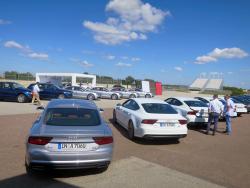 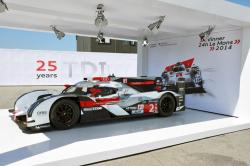 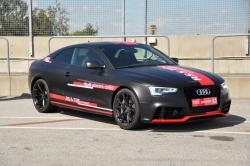 Audi TDI 25th Anniversary, Audi TDI Le Mans racecar, RS 5 TDI Concept. Click image to enlarge |
Article by Paul Williams, photos by Paul Williams and Audi AG
Copenhagen, Denmark – If you’ve ever wondered about the reliability and longevity of diesel engines, you’ve only to visit Copenhagen’s “Diesel House,” a museum/display centre where you’ll find what for 30 years was the world’s largest diesel engine (it’s 12.5 metres tall, 24.5 m long, and weighs 1,400 tons). It now runs only twice a week for demonstration purposes, but it used to run continuously.
Commissioned in 1933, this giant two-stroke, eight-cylinder engine powered the city of Copenhagen for decades, and from the 1970s until 2004 was still in commission as a standby unit. Built by the Burmeister & Wain (B&W) company who signed an exclusive agreement with Rudolf Diesel to build and develop diesel engines in Denmark, it makes 2,800 horsepower per cylinder; 22,400 hp total. The museum also houses a one-cylinder B&W engine delivered in 1904. It, too, still works like a charm.
Fitting, therefore, that Audi would choose Copenhagen as the location to celebrate the 25th anniversary of its Turbo Direct Injected (TDI) diesel engine, of which 7.5 million have been built since 1989. Over that period, the TDI has seen its power and torque relative to displacement increase by over 100 percent, while pollutant emissions have come down by 98 percent. The event in Copenhagen discussed the current state of TDI development and future directions for the technology.
The first TDI offered to consumers was found in the 1989 Audi 100, introduced at the Frankfurt Auto Show and powered by a 2.5-litre, inline five-cylinder engine making 120 hp. According to Jan Helbig, Mechanical Testing, TDI, the engne’s breakthrough technologies were turbocharging and direct injection of fuel into the cylinders, which was controlled by an electronic engine management system. These technologies continue to be the foundation of the TDI engine, although they have, of course, been refined over the years with Audi engineers focusing on using less fuel, making more power and significantly reducing, if not eliminating, emissions.
Currently Audi offers 156 TDI models (total for all markets), and has introduced an “ultra” line, examples of which represent the best fuel economy available to each model series. The Audi A3 ultra, for instance, returns 3.2 L/100 km.
Audi is also working to hybridize its diesel fleet and is planning to introduce plug-in diesel hybrids that can run a minimum of 50 km on battery alone. While moving forward on the electrification of the diesel, Audi continues to work on the more “classic” technology fields to reduce emissions, including friction reduction, thermal management and controlling the combustion process.
“Rightsizing” rather than downsizing is the company’s mantra: selecting the right engine size for the respective size of the car. Audi points out that the six- and eight-cylinder TDI engines, for example, have proven to be highly efficient because they can run smoothly at extremely low engine speeds.
Racing is also a factor in diesel technology development. Audi debuted the TDI engine at Le Mans in 2006 and has taken the chequered flag as overall winner eight times in nine starts since then, most recently in 2014 with a 1-2 finish. “In principle,” says Audi, “the same requirements apply on the racetrack and in production. The goal is to always get more and more out of every drop of fuel.”
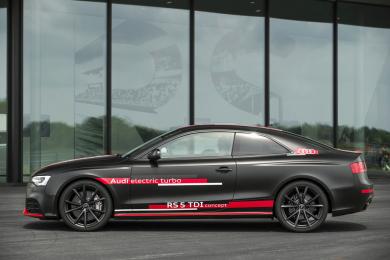 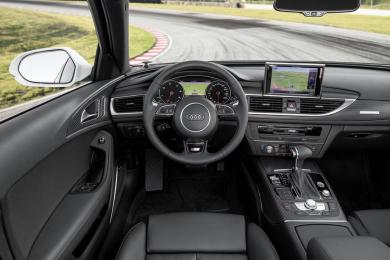 Audi RS 5 TDI Concept, driver’s seat. Click image to enlarge |
As mentioned above, turbocharging, fuel injection and emissions control are the three main drivers of TDI engine development. The turbocharger in the new 3.0 TDI, for instance, uses an electric actuator that adjusts the position of the turbine wheel vanes in increments of less than 200 milliseconds, and manages exhaust gases that reach temperatures of 830 degrees Celsius. This level of precision and control enables engineers to make small refinements that incrementally improve results.
Concerning fuel injection, with most engines Audi already uses peak pressures of 2,000 bar in its common-rail injection system. The pressure and its management are important because they influence the power available per litre of displacement in the engine, along with the smoothness of the engine’s operation. The next target, according to Audi, is 2,500 bar, and they point out that the Audi R18 e-tron quattro race car uses an injection pressure of 2,800 bar to produce 134 horsepower per litre of displacement, demonstrating the feasibility of the goal.









